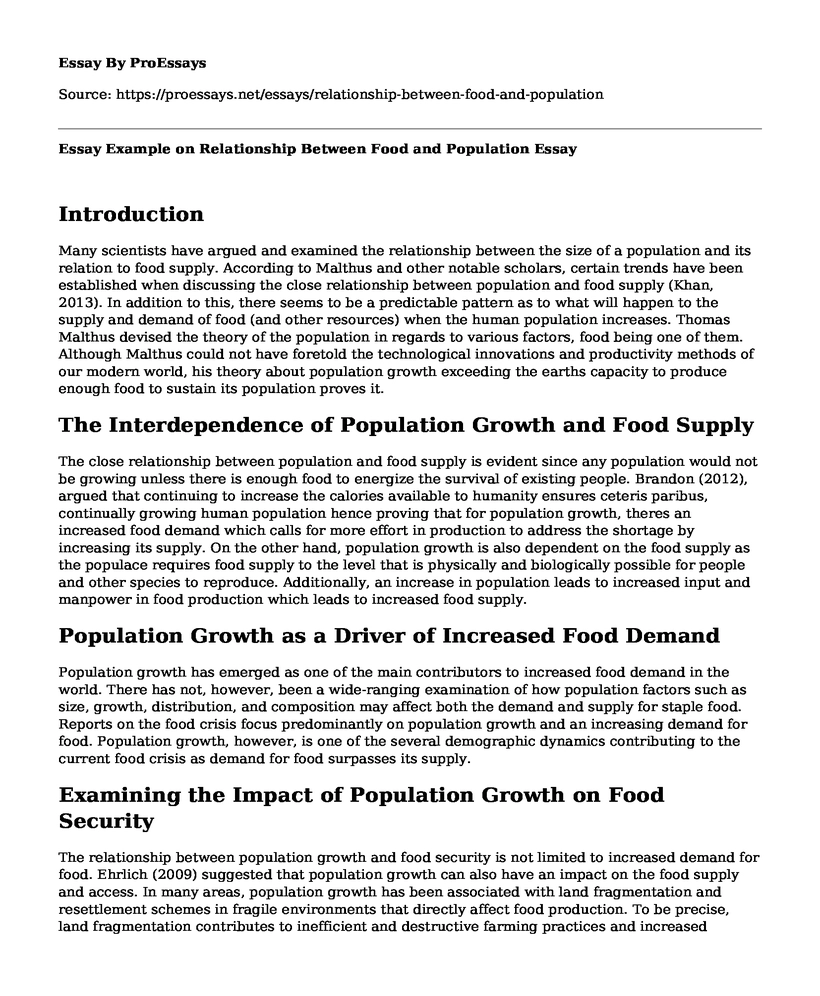Introduction
Many scientists have argued and examined the relationship between the size of a population and its relation to food supply. According to Malthus and other notable scholars, certain trends have been established when discussing the close relationship between population and food supply (Khan, 2013). In addition to this, there seems to be a predictable pattern as to what will happen to the supply and demand of food (and other resources) when the human population increases. Thomas Malthus devised the theory of the population in regards to various factors, food being one of them. Although Malthus could not have foretold the technological innovations and productivity methods of our modern world, his theory about population growth exceeding the earths capacity to produce enough food to sustain its population proves it.
The Interdependence of Population Growth and Food Supply
The close relationship between population and food supply is evident since any population would not be growing unless there is enough food to energize the survival of existing people. Brandon (2012), argued that continuing to increase the calories available to humanity ensures ceteris paribus, continually growing human population hence proving that for population growth, theres an increased food demand which calls for more effort in production to address the shortage by increasing its supply. On the other hand, population growth is also dependent on the food supply as the populace requires food supply to the level that is physically and biologically possible for people and other species to reproduce. Additionally, an increase in population leads to increased input and manpower in food production which leads to increased food supply.
Population Growth as a Driver of Increased Food Demand
Population growth has emerged as one of the main contributors to increased food demand in the world. There has not, however, been a wide-ranging examination of how population factors such as size, growth, distribution, and composition may affect both the demand and supply for staple food. Reports on the food crisis focus predominantly on population growth and an increasing demand for food. Population growth, however, is one of the several demographic dynamics contributing to the current food crisis as demand for food surpasses its supply.
Examining the Impact of Population Growth on Food Security
The relationship between population growth and food security is not limited to increased demand for food. Ehrlich (2009) suggested that population growth can also have an impact on the food supply and access. In many areas, population growth has been associated with land fragmentation and resettlement schemes in fragile environments that directly affect food production. To be precise, land fragmentation contributes to inefficient and destructive farming practices and increased cultivation of negligible land, which directly reduces food production. This, as a result, leads to famine and poverty as the population size cannot be adequately sustained by the available production from their land.
The world population conference held in Bucharest in 1974 put a lot of emphasis on agricultural and rural development as a means of influencing demographic change, and on the need to address the world food problems (Lio, & Liu, 2011). In conclusion, it was agreed that the issue of population growth is largely based on the balance of worlds population and global production of foodstuffs and volume of the available resource. This served as an enough proof that population sustainability depends on food production and its supply.
Conclusion
Many scholars have realized that increase in the population goes hand in hand with the increased consumption which calls for increased production. Therefore, there must be an equitable distribution of the same food for sustaining the population otherwise poverty will be inevitable. Food production is paramount in any economy both for its growth and its population as a hungry population is termed to be unproductive one. According to Abernethy (2012), several population factors play a significant role in the growing and changing nature of the demand for food, while also tightening supply and access to food. These factors include; rapid population growth, urbanization, the population density of the rural poor, and migration for employment and these are projected to cause problems in the coming decades if they are not addressed.
References
Abernethy, V. (2012). The demographic transition model: A ghost story. Population & Environment, 17(1), 3-6.
Brandon, Hembree,(2012) Food Supply vs. Population: Malthus 200 Years Later. Delta Farm Press. N.p., n.d. Web.
Ehrlich, A., & Ehrlich. P. (2009). The Population Bomb: Revisited. The Electronic Journal of Sustainable Development 1(3) 63-71.
Lio, M., & Liu, M. (2011). Governance and agricultural productivity: A cross-national analysis. Food Policy, 33(6)
Magdoff, F., & Tokar, B. (2009). Agriculture and Food in Crisis: An Overview. Monthly Review, 61(3), 1-16.
Sachs, J. (2011). Are Malthuss predicted 1798 food shortages coming true? (Extended version). Scientific American
Khan, S. (2013). Thomas Malthus and Population Growth.
Cite this page
Essay Example on Relationship Between Food and Population. (2021, Mar 11). Retrieved from https://proessays.net/essays/relationship-between-food-and-population
If you are the original author of this essay and no longer wish to have it published on the ProEssays website, please click below to request its removal:
- Sexual Assault in Colleges
- Police Brutality Against the African Americans Essay
- White Privilege Essay Example
- How Police Response to Domestic Violence Evolved Over the Last Three Decades - Paper Example
- Drug Policy of Foreign Countries Essay Example
- Creating Social Impact: Understanding Community Interest Companies - Essay Sample
- Comparative Analysis of John Brown and Timothy McVeigh: Terrorism, Motivations, and Methods







